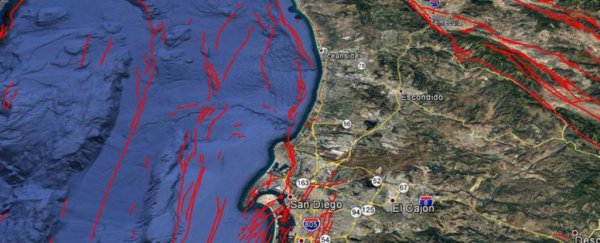Researchers have discovered that what they previously assumed were two separate fault zones below southern California are in fact part of one very intimidating 'mega fault' system.
When they investigated the possibility of all parts of the newly discovered fault system rupturing at once, they found that it could trigger a magnitude 7.4 earthquake extending all the way from LA to San Diego.
A quake of that size would be 30 times more powerful than the magnitude 6.4 Long Beach quake, which killed 120 people back in 1933.
For more recent perspective, a 2008 US Geological Survey report found that a magnitude 7.8 earthquake on the nearby southern San Andreas fault could cause more than 1,800 deaths, 50,000 injuries, and US$200 billion in damage.
Long-lasting infrastructure disruptions such as six months of compromised sewer systems and ongoing wildfires would also be a concern.
"The size of an earthquake is directly related to the length of the fault that's rupturing - the longer the fault, the larger the earthquake," lead researcher of the new study, Valerie Sahakian from the US Geological Survey, told Steph Yin from the New York Times.
Previous research had suggested that the two Newport-Inglewood and Rose Canyon fault zones were separated by gaps as wide as 4.8 km (3 miles), and for more than 30 years, scientists had assumed they weren't connected.
But the latest study found that the gaps were no more than 2 km (1.25 miles) wide at their largest point, suggesting that the fault zones are intricately linked.
"This means you're more likely to get an earthquake on all strands of the fault zone, as opposed to just a couple," Sahakian told Yin.
Parts of the fault zones run underwater, which is why they have been so difficult to study in the past. But the new study bounced acoustic waves off the seafloor to image the sedimentary layers below.
They then combined this data with previous seismic surveys, and found was that the fault lines weren't as distinct as previously assumed.
"Four main fault strands are identified offshore, separated by three main stepovers along strike, all of which are 2 km or less in width," the researchers write.
"Empirical studies of historical ruptures worldwide show that earthquakes have ruptured through stepovers with this offset."
Before you freak out, there's good and bad news about the newly identified Newport-Inglewood/Rose Canyon fault system.
The bad news is that its proximity to the coast means that, in the case of it rupturing, there's a high chance of land liquifying.
"Which means there will be a lot of damage to all kinds of coastal structures or piers," Caltech seismologist Egill Hauksson, who wasn't involved in the research, told the LA Times.
But the good news is that the chance of the entire fault system going off at once is pretty unlikely. The data suggest that all parts of the fault's strands haven't ruptured simultaneously in more than 11,000 years.
And when comparing the risk to other parts of California, the land on either side of the Newport-Inglewood/Rose Canyon fault is moving a lot slower than the land on either side of the southern San Andreas fault.
The land around the San Andreas fault is pushing against each other at a rate of more than 2.5 cm (1 inch) per year, leading scientists to label the fault as "locked, loaded, and ready to roll".
In contrast, the Newport-Inglewood/Rose Canyon fault is only moving around one-tenth of that amount annually.
"These faults are moving pretty slowly compared to the San Andreas, so the likelihood is pretty small - but it's still there," Hauksson told the LA Times.
"It's almost like a lottery ticket. If you buy a ticket, you have some chance of winning, but it's exceedingly small."
Now that scientists know more about the newly identified single fault system - and are getting a better understanding of what else lies beneath California - they'll hopefully be able to more accurately predict and prepare for earthquakes in the future.
The research has been published in The Journal of Geophysical Research.
